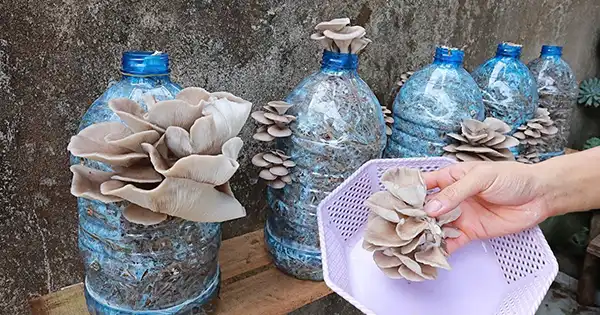How to Grow Mushrooms at Home in 5-Liter Plastic Bottles

Mushroom cultivation at home can be a rewarding and eco-friendly hobby that allows you to enjoy the delicious taste of fresh, homegrown mushrooms. One of the simplest and most efficient methods for cultivating mushrooms is by using 5-liter plastic bottles. In this article, we will guide you through the step-by-step process of growing mushrooms at home using straw, water, and mushroom seeds in plastic bottles. Follow these instructions to enjoy a bountiful harvest of your own mushrooms in just a few weeks.
Materials Needed:
- Straw
- Water
- Large pot for boiling
- Mushroom seeds (spawn)
- 5-liter plastic bottles with caps
- Clean cloth or plastic wrap
- Watering can or spray bottle
- A cool, dark place for incubation
Step 1: Preparing the Straw
Begin by gathering a sufficient amount of straw. Wheat straw or oat straw works well for mushroom cultivation. Cut the straw into small pieces, around 2-4 inches in length.
Step 2: Boiling the Straw
Place the chopped straw in a large pot and fill it with water. Bring the water to a boil and let it simmer for approximately 20 minutes. Boiling helps to sterilize the straw, eliminating any competing microorganisms that may hinder mushroom growth. After boiling, allow the straw to cool down to room temperature.
Step 3: Acquiring Mushroom Seeds
Purchase mushroom seeds, also known as mushroom spawn, from a reputable supplier. You can choose from a variety of mushroom species such as oyster, shiitake, or white button mushrooms, depending on your preference.
Step 4: Preparing the 5-Liter Plastic Bottles
Thoroughly clean and sterilize the 5-liter plastic bottles and their caps. Make sure they are completely dry before proceeding.
Step 5: Layering Straw and Mushroom Seeds
Open the plastic bottles and start by adding a layer of the cooled, boiled straw to the bottom of each bottle. Next, evenly spread a layer of mushroom seeds on top of the straw. Repeat this layering process until the bottle is nearly full, finishing with a layer of straw on top. Ensure the layers are evenly distributed for optimal mushroom growth.
Step 6: Incubation
Place the cap on each plastic bottle and cover the top with a clean cloth or plastic wrap. This allows for air exchange while maintaining a controlled environment. Place the bottles in a cool, dark location with temperatures ranging from 70°F to 75°F (21°C to 24°C). During the incubation period, which typically lasts about five days, the mycelium (the mushroom’s root system) will start to colonize the straw.
Step 7: Daily Watering
To ensure a successful mushroom harvest, you’ll need to keep the straw consistently moist. Water the mushrooms once or twice a day using a watering can or a spray bottle. Be careful not to overwater, as excessive moisture can lead to contamination.
Step 8: Harvesting
After approximately 21 days, you’ll start to see mushroom pins (tiny mushroom primordia) forming inside the plastic bottles. Continue to maintain the moisture levels. As the pins grow, they will develop into mature mushrooms. Harvest the mushrooms by gently twisting and pulling them from the substrate when they reach their desired size.
Step 9: Continued Harvesting
You can continue to harvest mushrooms for several weeks after the initial harvest, as new pins will continue to develop inside the bottles. Be sure to harvest the mushrooms before they release spores, as spores can negatively affect future mushroom crops.
Disclaimer:
Growing mushrooms at home requires attention to detail and proper sterilization to prevent contamination. It’s essential to exercise caution and adhere to safety guidelines when handling potentially contaminated materials or consuming homegrown mushrooms. If you have any doubts or concerns, consult with local experts or mycology professionals for guidance.
Conclusion:
Growing mushrooms at home using 5-liter plastic bottles is a compact and efficient way to enjoy a steady supply of fresh, homegrown mushrooms throughout the year. Experiment with different mushroom species and techniques to expand your culinary horizons and enjoy the fruits of your labor. Happy mushroom growing!



















